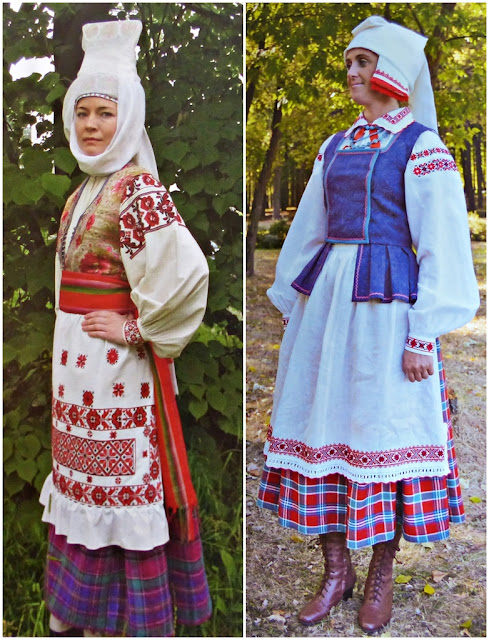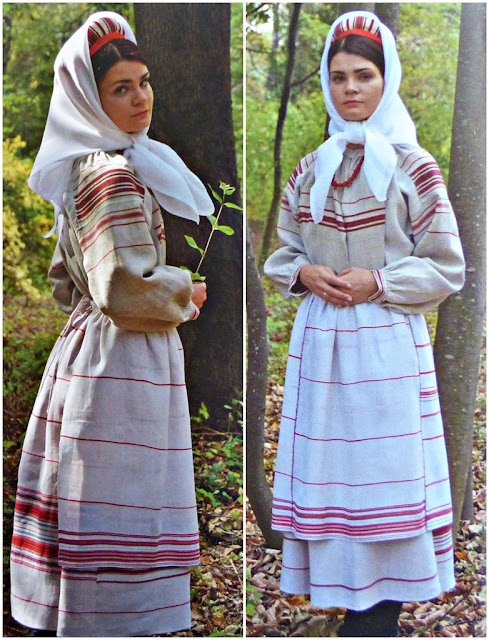 Summer male and female costumes, Pinsk district of Brest region, Western Palesse
Summer male and female costumes, Pinsk district of Brest region, Western PalesseThe territory of Belarus is subdivided into six historical and ethnographic regions with specific features of traditional costume. Besides, costumes from different districts of the same region have their unique and characteristic features and vary in their decoration and ornament or in the way of styling. But the basic pieces are similar on the whole territory and let's have a look at them first.
Historically traditional clothes of Belarus people were almost completely made of home-made fabrics and decorated with woven and embroidery ornament. Flax and hemp were cultivated on the farms and widely used for making clothing along with wool and leather.
The basic component of both male and female costumes is a long linen shirt. Women wear a skirt over the shirt which is made from woolen, half-woolen or linen fabric and has different names - andarak, spadnitsa, yupka. It is constructed of several pieces of cloth sewn together. The ordinary type is sewn from three, four or six pieces that are gathered or pleated into the waistband. The paniova, the earliest type of skirt, consists of pieces of cloth, often four, which are attached to the waistband but unsewn at the sides.
Festive dresses of girls, Pruzhany district, Brest region, Western Palesse
And apron, fartukh, is an obligatory element of married women clothes. The cut and appearance of Belarussian aprons are similar to those of Ukrainian, Lithuanian, Latvian, Estonian and Polish aprons. The apron, usually made of linen, has a waistband. It can be constructed of one, two, two and a half or even three pieces of cloth and its length normally matches the length of the skirt.
White festive aprons from southeastern areas are decorated with woven or embroidered designs. On the northwest, aprons were used only for work and are embellished modestly or not at all. Sleeveless vests are a later component of the folk costume. In some villages they were not used at all while in others they were worn only by older women. Elsewhere, they were a necessary element of girls' apparel and were included in the dowry. They have various names: kobat, shnurowka, harset. Vests are fastened at the front or slightly to the side with buttons covered with the same material as the vest. Usually brightly coloured purchased fabric was used decorated with embroidery or appliqué work.
Festive costume of a girl, Luki village, Homel region, Eastern Palesse
The traditional male outfit is very similar to that of other Slavic people. Pants (partki), a shirt (kashulia) and a belt are the basic garments of the Belarus peasant.
The typical male shirt was made of homemade linen of poorer quality with sleeves of two types: straight for everyday or with cuffs. The shirt typically reaches the knee. It is worn outside the pants and tied with a belt or sash. In some areas of the country, predominantly in the west, shirts were worn tucked into pants.
Male attire is neither as brightly nor as richly embellished as women's. Only the collar, front opening, cuffs and hem of the festive shirt have woven or embroidered ornamentation. Thy typical pants were again made of poorer quality linen while festive pants were made of thinner and finer wool. Much attention was paid to a belt in a men costume. Every man owned several belts used for different occasions. They were plaited, woven or less often knitted. Traditionally a purse for small items was often tied onto it.
Festive male and female costumes, Kalinkavichy district, Homel region, Eastern Palesse
The vest (spantserka, zhyletka) was a common garment, especially in western Belarus. Usually dark-coloured they were made from homemade fabric or more rarely from purchased material. Sometimes two kinds of fabric were combined in one vest, with the high quality material being used for the front and poor quality material for the back.
Belarusian girls would leave their heads uncovered having their hair pleated or they wore a narrow ornamented strip of cloth bound around the head. After changing her marital status a woman changed her hairstyle and headgear. A long piece of fine white linen cloth ornamented at the corners (nametka) was twisted in a certain manner to completely cover the hair. Hard structures of various forms such as straw, linen fiber, unspun flax, sycamore leaves etc. were used to help creating a hairstyle and to model the form of the whole dress. The cap was another important form of women's headgear. It was sewn of thing soft fabric or knitted. Usually caps were tied under the chin or at the back. Caps tied under chin were called kaptury and were embellished all over with embroidery, beads, lace. Caps tied at the back were embellished only on the forehead parts. By the beginning of the 20th century women no longer wore caps or head wraps. Kerchiefs became the most common headgear throughout Belarus. Men's hats were commonly made of felted wool, sheepskin, cloth or plaited straw.
1. Festive costume of a married woman, Zhytkavichy district, Homel region, Eastern Palesse
2. Festive costume of a married woman, Rahachow district, Homel region, Eastern Palesse
As everyday shoes, both men and women wore bast, leather or rope shoes. On holidays men put on high boots, women wore boots with heels or high boots.
Svitka (overcoat) and kashukh (sheepskin coat) were worn both by women and men as outerwear in the cold season. Svitkas were made of home-made cloth by professional tailors. Festive svitkas were decorated with patches of multi-coloured cloth, ribbons, cords, tassels and pompons.
Winter male and female overcoats kazhukhs, Zhukevichy village, Hrodna region, the Nioman area
A married woman wearing winter overcoat svitka, Pinsk district, Brest region, Western Palesse
And now let's have a closer look at some regional differences. Western Palesse covers the major part of the modern territory of Brest region. Peculiar natural and geographic conditions -intense swampiness of the territory, isolation of settlements from big roads and cities contributed to the preservation of ancient cultural traditions. Typical features of the costume of central districts of Brest region were the following: domination of white colour in all basic types of linen clothes, moderate decoration which mainly included red stripes and a very plain geometric ornament.
Colour intensity, an abundance of ornamental decoration was typical of south-western districts of Brest region. Rhombic-form-geometrical ornament compactly inserted into border red stripes compositions was widely used in the decoration of clothes articles.
Summer costume of a married woman with a cap and a headscarf, Abrova village, Brest region, Western Palesse
Festive costume of a married woman, Malaryta district, Brest region, Western Palesse
Festive dresses of a girl and a young man, Brest district, Brest region, Western Palesse
Festive costume of a married woman with a headdress kaptur, Brest district, Brest region, Western Palesse
Summer costume of a married woman, Stolin district, Brest region, Eastern Palesse
Summer costume of a townswoman with a headdress halava, Stolin district, Brest region, Eastern Palesse
The Dniapro area occupies a large territory of the east of Belarus. It almost completely covers Mahiliow region. On the south it borders with Ukraine, on the east -with Russia. On the south of the region a female costume reflects certain features close to the costume of Ukraine: similarity of decoration of shirts with wide sleeves and an ornamented hemline, use of a long slim-waisted sleeveless jacket, unique headdress. In eastern districts of the Dniapro area a certain type of clothes in the form of a long skirt with a short body sewn to it was quite popular. Variants of these clothes were known on the neighbouring territory of Smalensk region of Russia.
Festive costume of a married woman, Dobrush district, Homel region, the Dniapro area
Festive costume of a girl with girdled open paniova, Vetka district, Homel region, the Dniapro area
Festive costume of a young woman, Horki district, Mahiliow region, the Dniapro area
The Dzvina area occupies the major part of modern Vitebsk region. A traditional costume on this territory went out of use much earlier than in other regions of Belarus. Some preserved costumes and those reconstructed on the basis of literary sources and photos give us an idea of their delicate beauty which was not in the decoration spleandour but in precise proportions of various elements of clothes, their colour combinations, a particular silhouette of dresses, their harmony with nature.
Dresses of newlyweds, Vitebsk region, the Dzvina area
The Nioman area primarily covers the territory of modern Grodno region. Neighbourhood to Poland and Lithuania as well as the fact of being a part of Poland in 1921-1939 had a significant impact upon the development of the regional culture. Traditional clothes here, like those on the territory of the Dzvina area started to go out of use as early as in the middle of the 19th century.
1. Festive costume of a young woman, the Nioman area
2. Festive costume of a young woman, Maladzechna district, Minsk region, the Nioman area
Costume of some Central Belarus districts impress with the abundance of red colour, wealth of complicated multilayered ornamental compositions on shirts, aprons and headdresses while costumes of some other districts are formed with narrow stripes which are united into complex rhythmical compositions.
Festive costume of a married woman, Kletsk district, Minsk region, Central Belarus
Festive costume of a girl, Liakhavichy district, Brest region, Central Belarus
References:
Encyclopedia of World Dress and Fashion, Vol.9, East Europe, Russia, and the Caucasus.
Traditional Belarusian Costume by M. Vinnikava and P. Bohdan
Беларускi касцюм. В.Бялявiна, Л.Ракава
If you enjoyed the post please like my page on Facebook
Thank you!




















Wow!!! Great article!!!! Amazing photos too!!!! The costumes look so beautiful!!! I particularly love the embroidery and those colourful ribbons and skirts and vests!!! Pity that now majority of people dont dress in bright colours...
ReplyDeleteКакие невероятные костюмы, прекрасные фотографии! Действительно так отличаются от региона к региону, даже поразительно. Это ты сама написала? Сколько ж работы ты проделала, Оленька! Огромное удовольствие получила, буду возвращаться к твоим постам.
ReplyDeleteHello Everyone!!!
ReplyDeleteI would love to find those beautiful creations! is it possible in Europe?
Thanx to share with us valuale information and if you want to choose best wedding or other photographer from surat then you can write the wedding photography near me.
ReplyDeletevery good site and valuable information. thank you
ReplyDeleteThanks for sharing this wonderful post with us. If you’re in the fashion retail industry, you know how important it is to offer unique and trendy womens fashion clothes. That’s why I highly recommend Tamooya! Their wholesale selection is vast, covering everything from casual wear to sophisticated outfits, all at great prices. What I love most is that the clothing feels high-end but still allows me to price it competitively. Tamooya excellent customer service and fast shipping have made them my top choice for restocking my boutique.
ReplyDeleteDonation benefit giveaway 1,500,000.00, We are randomly select some people on online to receive a donation
ReplyDeleteGood day
Ms. Beate Heister, a German entrepreneur, investor, and Shareholder of the discount supermarket chain Aldi 25% of her personal wealth is spent on charity work around the world. she also promised the remaining 25% to private individuals this year. she have decided to randomly select some people on online to receive a donation amount of 1,500,000 euros each. This is part of her promises to the charity project this year. If you are interested in her donation, contact this official Emails: contact@beateheister.org beateheister3@gmail.com for more information.
Managing Director Beate Heister Siepmann Foundation Group Organizations (NGO)
Ms. Beate Heister: Secretary and media management.